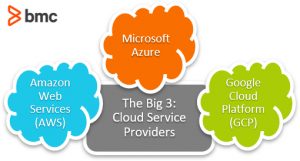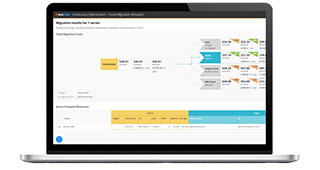Cloud computing has revolutionized the way organizations work, and advancing us to a new technology era. Amazon Web Services, Microsoft Azure, and Google Cloud Platform are the top cloud service providers that dominate the worldwide cloud market.
Nowadays, most enterprises are moving towards the cloud and even multi-cloud environments to harness the benefits offered by cloud computing, such as:
- Decreased CapEx
- Reduced infrastructure maintenance
- Increased availability
- Scalability
Of course, the Big 3 cloud providers possess the experience and expertise to provide a reliable and feature-rich cloud platform. But, before committing to a specific cloud platform, you must do your due diligence and compare each platform to fully understand their capabilities and differences.
In this post, we will see how these platforms stack up against the others.

Amazon Web Services (AWS)
The current market leader of the cloud computing platforms, Amazon Web Services is a subsidiary of Amazon.com, Inc. AWS is the most mature cloud platform offering a wide range of services to practically everyone: individual developers, large enterprises, and even governments.
AWS started its life as an internal cloud offering. By 2006, it had evolved into a publicly available cloud platform with services like Amazon S3 cloud storage and elastic compute cloud (EC2). AWS now offers more than 200 fully featured services to cater to any demand and serve millions of users.
Prominent AWS customers include:
- Expedia
- Netflix
- Coinbase
- Formula 1
- Coca Cola
- Intuit
- Airbnb
- Lyft
- Coursera
- Food and Drug Administration (FDA)
(Explore our AWS Guide, a series of articles & tutorials.)
Microsoft Azure
Microsoft Azure is the second-largest cloud platform. Debuting in 2010, Azure has evolved into a cloud platform with more than 200 products and services. Today, it is among the fastest-growing cloud platforms.
As Microsoft offers Azure, it provides a wide array of services tailored particularly for Microsoft-centric enterprises—making the switch to a cloud or a hybrid-cloud environment smooth for many organizations. In use by more than 95% of Fortune 500 companies, Microsoft Azure has a proven track record in catering to enterprise users.
Importantly, Azure is not limited to Windows-based services. It also supports open-source languages, technologies, and platforms, giving anyone the freedom to build and support any application.
Well-known Azure customers include:
- DAIMLER AG
- McKesson Group
- Asos
- Center of Disease Control (CDC) – US
- National Health Service (NHS) – UK
- HSBC
- Starbucks
- Walgreens
- 3M
- HP
- Mitsubishi Electric
- Renault
(Explore popular Azure certifications.)
Google Cloud Platform (GCP)
The Google Cloud Platform is the cloud offering by none other than Google. GCP is part of the overarching Google Cloud.
Available to the general public beginning in 2010, the Google Cloud Platform currently offers over 100 services spanning computing, networking, big data, and more. Today GCP consists of services including Google Workspace, enterprise Android, and Chrome OS.
Compared to AWS and Azure, GCP is the smallest of the Big 3 cloud providers. Yet it offers a robust set of cloud services to power and support any kind of application.
Notable GCP customers include:
- Toyota
- Unilever
- Nintendo
- Spotify
- The Home Depot
- Target
- Paypal
- UPS
Planning to migrate to the cloud? Check out the BMC Helix Platform.›
How to choose a cloud service provider
There are many factors to consider when choosing a CSP. Let’s take a look at the most common angles.
Regions and availability
When choosing a cloud provider, the first thing to consider is its supported regions and availability. These directly impact the performance of your cloud, due to factors like latency and compliance requirements, especially when dealing with data.
As of September 2021, here’s where the Big 3 stand:
- Amazon Web Service has 25 geographic regions with 81 availability zones. 218+ edge locations, and 12 Regional Edge Caches.
- Microsoft Azure runs 60+ regions with a minimum of three availability zones in each region with more than 116 edge locations (Points of Presence).
- Google Cloud Platform has 27 cloud regions with 82 zones and 146 edge locations.
All these platforms provide specialized cloud solutions for the government (Government Cloud). Furthermore, both AWS and Azure offer specialized services that cater to the Chinese market with data centers located in China.
Azure has the broadest geographic coverage compared to the others, while all platforms cover most of the globe. And, showing no signs of slowing, all providers continuously expand their coverage by adding more regions and zones to meet the ever-increasing computing demand.
(Get an in-depth look at the Big 3 regions & availability.)
Common services
AWS and Azure have the largest service catalogs by offering more than 200+ services. GCP currently offers around 100+ services. A general breakdown of services is:
- AWS has the largest catalog of services.
- Azure is a close second with an impressive set of AI, ML, and analytics services.
- Google Cloud Platform comes in third place for the number of services offered.
In this section, let’s take a look at the common service offerings of each cloud platform.
Compute Services
| Service | AWS | Azure | GCP |
|---|---|---|---|
| VM (Compute Instance) | EC2 (Elastic Compute) | Azure Virtual Machine | Google Compute Engine |
| PaaS | AWS Elastic Beanstalk | App Service | Google App Engine |
| Container | AWS Elastic Container/Kubernetes Service | Azure Kubernetes Service (AKS) | Google Kubernetes Engine |
| Serverless Functions | AWS Lambda | Azure Function | Google Cloud Functions |
Database & Storage Services
| Service | AWS | Azure | GCP |
|---|---|---|---|
| RDBMS (Multiple Database Types – SQL, MySQL, etc..) | AWS RDS | Azure SQL/ Database for MySQL/PostgreSQL | Cloud SQL |
| NoSQL | DynamoDB, Simple DB | Azure Cosmos DB, Table Storage | BigTable, Cloud Datastore |
| Object Storage | S3 (Simple Storage Service) | Blob Storage | Google Cloud Storage |
| File Storage | Elastic File System | Azure File Storage | Google Filestore |
| Archive Storage | Amazon Glacier | Azure Archive Storage | Google Storage (Archive Storage) |
| Data Warehouse/Data Lake | Amazon Redshift | Azure Synapse Analytics | Google BigQuery |
Networking
| Service | AWS | Azure | GCP |
|---|---|---|---|
| Virtual Network | Virtual Private Cloud (VPC) | Virtual Network (Vnet) | Virtual Private Cloud (VPC) |
| Load Balancing | Elastic Load Balancer | Azure Load Balancer | Google Cloud Load Balancing |
| Firewall | AWS Firewall / Web Application Firewall | Azure Firewall | Google Cloud firewalls |
| DNS | Route 53 | Azure DNS | Google Cloud DNS |
| CDN | Amazon CloudFront | Azure Content Delivery Network (CDN) | Cloud CDN |
As you can see, all three providers offer comparable services to cover the common computing needs of users. However, there are basic differences in two general categories:
- How each service is implemented in its cloud platform
- The individual features available for each service
Specialized services
When it comes to specialized services, we notice significant differences in the services available with AWS and Azure, far surpassing GCP.
| Service | AWS | Azure | GCP |
|---|---|---|---|
| DevOps | CodePipeline, CodeBuild, CodeDeploy, CodeStar | Azure Boards, Pipelines, Repos, Test Plans, Artifacts | GCP DevOps CloudBuild, Artifact Registry |
| AI & ML | Amazon SageMaker, Amazon Comprehend, Amazon Lex, Amazon Polly | Azure Machine Learning, Azure Databricks, Azure Cognitive Search, Azure Bot Service, Cognitive Services | Vertex AI, AutoML, Dataflow CX, Cloud Vision, Virtual Agents |
| IoT | FreeRTOS, IoT Core, Greengrass, IoT Analytics, SiteWise | Azure IoT Hub/Central, IoT Edge, Azure Sphere, Azure RTOS | Google Cloud IoT Core |
| AR & VR | Amazon Sumerian | Azure Mixed Reality (Spatial Anchors/Remote Rendering) | ARCore |
| Game Development | Amazon GameLift | Azure PlayFab | |
| Business Analytics | Amazon Quicksight | Azure Power BI | Looker |
| End-User Computing | Amazon Workspaces | Azure Virtual Desktop | |
| Robotics | AWS RoboMaker |
These are only some of the specialized services available with these platforms—AWS users can even dabble with quantum computing using Amazon Braket!
Pricing
The pricing of the cloud platform depends on many factors:
- Customer requirements
- Usage
- The services used
All three platforms offer competitive pricing plans with additional cost management options—reserved instances, budgets, and resource optimization—available to all users.
The consensus in the IT community is that Microsoft Azure has the lowest on-demand pricing while Amazon tends to come somewhere around the middle. However, there is a clear advantage when enterprise customers already using Microsoft services (Windows, active directory, MS SQL, etc.) move to Azure as it is significantly cheaper than other cloud providers.
AWS vs Azure vs GCP: pros & cons
| AWS | |
|---|---|
| Pros | Cons |
|
|
| Microsoft Azure | |
| Pros | Cons |
|
|
| GCP | |
| Pros | Cons |
|
|
Take IT Service Management to the next level with BMC Helix ITSM.›
Summing up the Big 3
Even though AWS is the current market leader in terms of capacity and service, Microsoft and Google are also rapidly growing to compete with AWS.
Microsoft in particular is hot on the heels of AWS with its strong emphasis on the enterprise. Meanwhile, Google continues to evolve its presence by providing excellent integrations with open-source projects and third-party services.
In the end, of course, it all boils down to your specific use case. As the market grows, most enterprises are looking for multi-cloud strategies to leverage the strengths offered by each cloud provider without locking themselves to a single provider.







